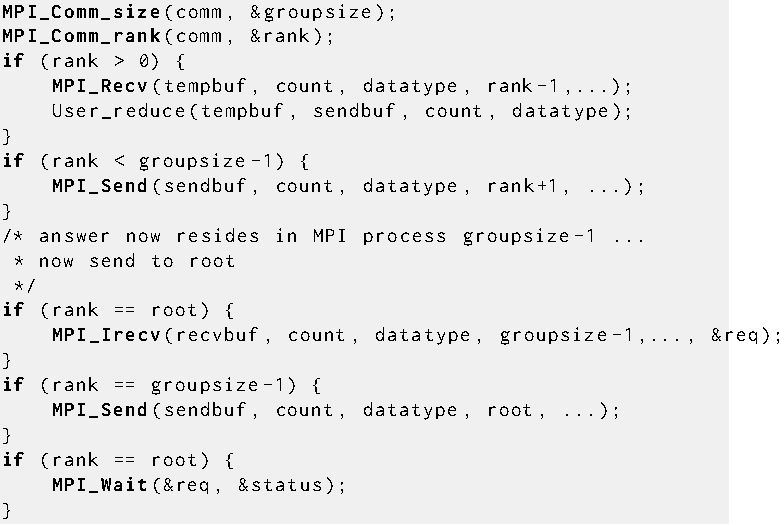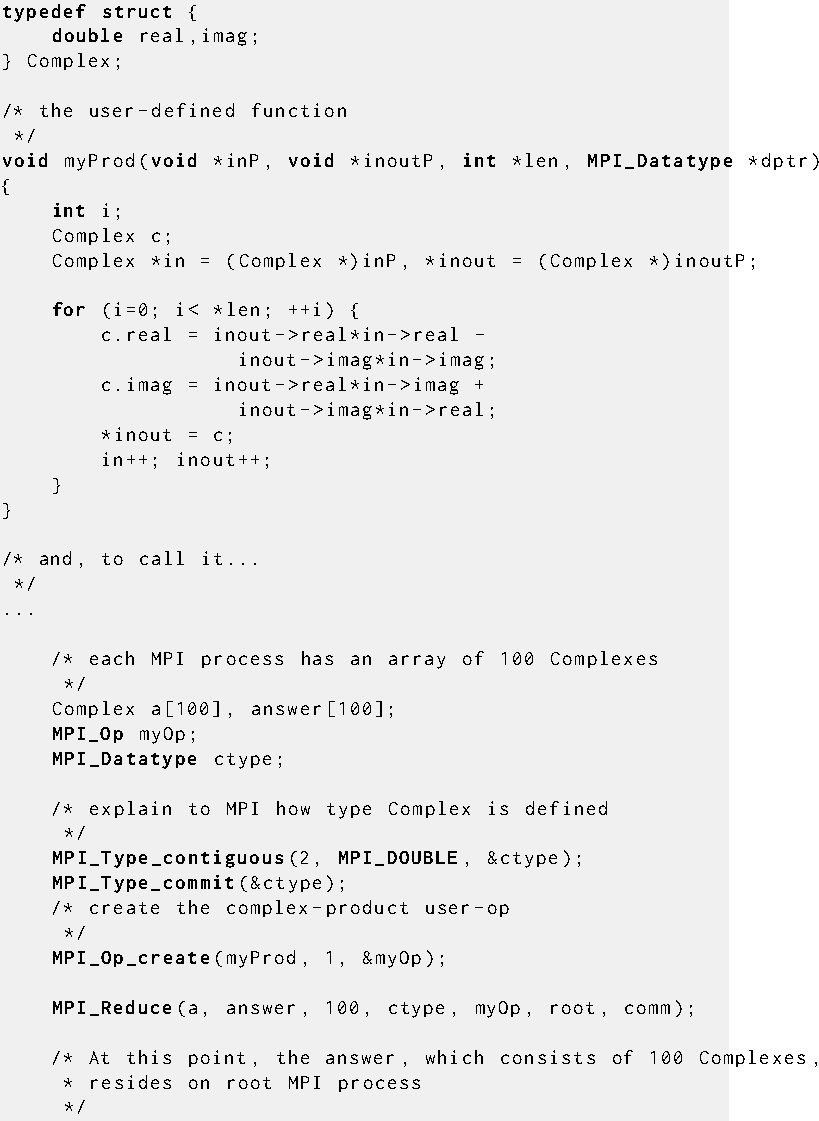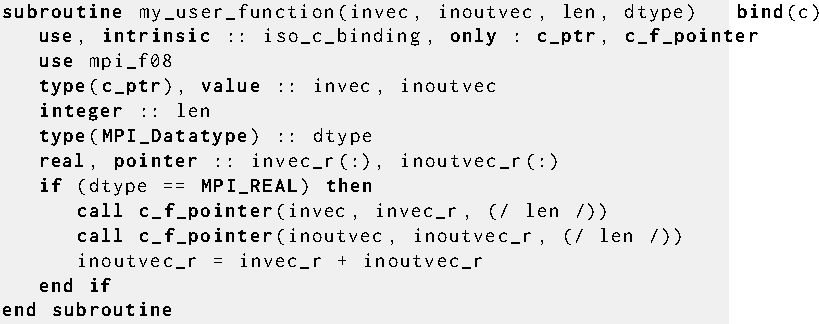| MPI_OP_CREATE(user_fn, commute, op) | |
| IN user_fn | user defined function (function) |
| IN commute | true if commutative; false otherwise. |
| OUT op | operation (handle) |
MPI_OP_CREATE binds a user-defined reduction operation to an op handle that can subsequently be used in MPI_REDUCE, MPI_ALLREDUCE, MPI_REDUCE_SCATTER, MPI_REDUCE_SCATTER_BLOCK, MPI_SCAN, MPI_EXSCAN, all nonblocking and persistent variants of those (see Section Nonblocking Collective Operations and Section Persistent Collective Operations), and MPI_REDUCE_LOCAL. The user-defined operation is assumed to be associative. If commute = true, then the operation should be both commutative and associative. If commute = false, then the order of operands is fixed and is defined to be in ascending, process rank order, beginning with MPI process with rank 0 in the communicator comm. The order of evaluation can be changed, talking advantage of the associativity of the operation. If commute = true then the order of evaluation can be changed, taking advantage of commutativity and associativity.
In Fortran when using USE mpi_f08, the large count variant shall be called explicitly as MPI_Op_create_c (i.e., with suffix ``_c'') because interface polymorphism cannot be used to differentiate between the two different user callback prototypes despite their different type signatures.
The argument user_fn is the user-defined function, which must have the following four arguments: invec, inoutvec, len, and datatype.
MPI_USER_FUNCTION also supports large count types in separate additional MPI callback function prototype declarations in C (suffixed with the ``_c'') and in Fortran when using USE mpi_f08.
The ISO C prototypes for the functions are the following.
typedef void MPI_User_function(void *invec, void *inoutvec, int *len, MPI_Datatype *datatype);
typedef void MPI_User_function_c(void *invec, void *inoutvec, MPI_Count *len, MPI_Datatype *datatype);
The Fortran declarations of the user-defined function user_fn appear below.
ABSTRACT INTERFACE
SUBROUTINE MPI_User_function(invec, inoutvec, len, datatype)
USE, INTRINSIC :: ISO_C_BINDING, ONLY : C_PTR
TYPE(C_PTR), VALUE :: invec, inoutvec
INTEGER :: len
TYPE(MPI_Datatype) :: datatype
ABSTRACT INTERFACE
SUBROUTINE MPI_User_function_c(invec, inoutvec, len, datatype) !(_c)
USE, INTRINSIC :: ISO_C_BINDING, ONLY : C_PTR
TYPE(C_PTR), VALUE :: invec, inoutvec
INTEGER(KIND=MPI_COUNT_KIND) :: len
TYPE(MPI_Datatype) :: datatype
SUBROUTINE USER_FUNCTION(INVEC, INOUTVEC, LEN, DATATYPE)
<type> INVEC(LEN), INOUTVEC(LEN)
INTEGER LEN, DATATYPE
The datatype argument is a handle to the datatype that was passed into the call to MPI_REDUCE. The user reduce function should be written such that the following holds: Let u[0], ..., u[len-1] be the len elements in the communication buffer described by the arguments invec, len and datatype when the function is invoked; let v[0], ... , v[len-1] be len elements in the communication buffer described by the arguments inoutvec, len and datatype when the function is invoked; let w[0], ... , w[len-1] be len elements in the communication buffer described by the arguments inoutvec, len and datatype when the function returns; then w[i] = u[i]°v[i], for i=0 , ... , len-1, where ° is the reduce operation that the function computes.
Informally, we can think of
invec and inoutvec as arrays of len elements that
user_fn
is combining. The result of the reduction over-writes values in
inoutvec, hence the name. Each invocation of the function results in
the pointwise evaluation of the reduce operator on len
elements:
i.e., the function returns in inoutvec[i] the value
![]() , for
, for ![]() ,
where ° is the combining operation computed by the function.
,
where ° is the combining operation computed by the function.
Rationale.
The len argument allows MPI_REDUCE to avoid calling the function for each element in the input buffer. Rather, the system can choose to apply the function to chunks of input. In C, it is passed in as a reference for reasons of compatibility with Fortran.
By internally comparing the value of the datatype argument to
known, global handles,
it is possible to overload the use of a single user-defined function
for several, different datatypes.
( End of rationale.)
When calling any reduction or prefix scan MPI procedure with a
user-defined MPI operator, the type of the count parameter in
the call to the reduction or prefix scan MPI procedure does not need
to be identical to the type of the len parameter in the user
function associated with the user-defined MPI operator. If the
count parameter has a type of int in C or
INTEGER in Fortran and the len parameter has a type
of MPI_COUNT, then MPI will perform the appropriate widening
type conversion of the len parameter. If the count
parameter has a type of MPI_COUNT and the len
parameter has a type of int in C or INTEGER in
Fortran, then MPI will perform the appropriate narrowing type
conversion of the len parameter. If this narrowing
conversion would result in truncation of the len value, then
MPI will call the user function multiple times with a sequence of
values for len that sum to the value of count.
Advice
to implementors.
If the number of data items cannot be represented in len,
the implementation may need to invoke user_fn multiple
times.
( End of advice to implementors.)
General datatypes may be passed to the user function.
However, use of datatypes that are not contiguous is likely to lead to
inefficiencies.
No MPI communication function may be called inside the user function. MPI_ABORT may be called inside the function in case of an error.
Advice to users.
Suppose one defines a library of user-defined reduce functions that are overloaded: the datatype argument is used to select the right execution path at each invocation, according to the types of the operands. The user-defined reduce function cannot ``decode'' the datatype argument that it is passed, and cannot identify, by itself, the correspondence between the datatype handles and the datatype they represent. This correspondence was established when the datatypes were created. Before the library is used, a library initialization preamble must be executed. This preamble code will define the datatypes that are used by the library, and store handles to these datatypes in global, static variables that are shared by the user code and the library code.
The Fortran version of MPI_REDUCE will invoke a user-defined reduce
function using the Fortran calling conventions and will pass a Fortran-type
datatype argument; the C version will use C calling convention and the C
representation of a datatype handle. Users who plan to mix languages should
define their reduction functions accordingly.
( End of advice to users.)
Advice
to implementors.
We outline below a naive and inefficient implementation of MPI_REDUCE not supporting the ``in place'' option and only valid for intra-communicators.

The reduction computation proceeds, sequentially, from MPI process with rank 0 to MPI process with rank groupsize-1. This order is chosen so as to respect the order of a possibly noncommutative operator defined by the function User_reduce(). A more efficient implementation is achieved by taking advantage of associativity and using a logarithmic tree reduction. Commutativity can be used to advantage, for those cases in which the commute argument to MPI_OP_CREATE is true. Also, the amount of temporary buffer space required can be reduced, and communication can be pipelined with computation, by transferring and reducing the elements in chunks of size len <count.
The predefined reduce operations can be implemented as a library of
user-defined operations. However, better performance might be
achieved if MPI_REDUCE handles these functions as a special
case.
( End of advice to implementors.)
| MPI_OP_FREE(op) | |
| INOUT op | operation (handle) |
Marks a user-defined reduction operation for deallocation and sets op to MPI_OP_NULL.
The example in this section uses an intra-communicator.
Example
Compute the product of an array of complex numbers, in C.

Example
How to use the mpi_f08 interface of the Fortran MPI_User_function.
